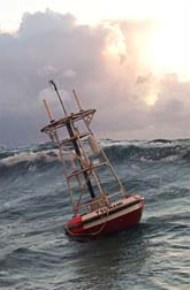|
|
|
QUICK
LINKS |
|
-- Sea Morphology
Changes and Sensor Placement
|
|
-- Team 5 Home
-- Mission 2009
-- MIT |
|
|
Tsunami
Formation
Tsunamis:
Generation
and Propagation
Tsunamis, often incorrectly referred to as tidal waves, are generated
in a variety
of ways. Regional uplifting along the seafloor (earthquakes) is
the most
common cause of tsunamis, and tends to generate tsunamis that
result in
enormous amounts
of destruction and that may travel for thousands
of miles
before stopping (Alaska Sea Grant 2005). Underwater
landslides, which occur when large masses of
sediment shift along the seafloor, are another
common
cause of tsunamis. The tsunamis generated by landslides tend to be
relatively
localized and typically do less damage than the earthquake
generated tsunamis. Finally, volcanoes
and local landslides along the coast can
generate tsunamis as well. These
tsunamis are highly localized, however, and
generally affect only a central area.
The "lifetime" of a
tsunami can be divided up into three stages:
generation,
propagation, and runup. (Comer 1978) Of these, we are most
concerned with the first two. In
our study we will be trying to best monitor the
generation of tsunamis, and, after
they are generated, understand the direction
of tsunami
propagation.
The
power of a tsunami is highly dependent on two factors: seafloor morphology and
tide. The shape of the ocean floor alters
the height of the tsunami by changing
the ratio between the wavelength and the
wave height of a tsunami.
In general, the ratio of wavelength to
wave height decreases as the wave travels into
shallower water, causing the tsunami to
grow in size (Smith
2005). The tide also plays a role in the
damage a tsunami will do to an area: at high tide
the tsunami will be able to do much more
damage than at low tide.
Tsunamis: Peru and
Micronesia
Both
of the countries examined in this study are located in the equatorial humid
zone. This zone has the highest rate
of sedimentation, accumulation roughly 76% of the sediments flowing
into the
ocean. This increased sedimentation results in a higher rate of ocean
floor slumping, which in turn results in a higher potential for tsunami
generation (Gusiakov 2005).
The
probability of tsunami generation is further increased in the South
American region by the location of the fault
line running along the South American coastline. The source of
earthquakes along in the South American
region (the fault line) is located very close to
the coastline, and as a resultThe
probability of tsunami generation is further increased in the South
American region by the location of the fault
line running along the South American coastline. The source of
earthquakes along in the South American many of the earthquakes along
the fault have a
large potential of being tsunamigenic. (Gusiakov 2005) This
potential is further increased by the high slope gradient between the
Peru-Chile trench and
the nearby Cordilleras Mountains, which results in an increase in the
amount of erosion and sediment going into the nearby ocean.
The chart below shows the
relative damage of the tsunamis that occurred in each region over the
past century. The black
sections of the graph are the percentage of highly damaging tsunamis
that occurred in
each region. Both the South American and New Guinea and Solomon I
regions
have relatively high percentages of damaging earthquakes, indicating
that
these are both high-risk areas. These regions are believed to be at
such high
risk that Gusiakov classifies them as being in the "red" category, or
highest risk area.
Because Peru and
Micronesia are both developing nations and because both fall under the
"high risk" category, many experts believe that it
will be impractical to design a system built
only to issue warnings when completely certain
of tsunami
risk. Instead, it will be much more effective to build a
system which will respond when there is any large danger of a tsunami
(Woo and
Aspinall 2005). This is in large part because, as
developing
countries, both Peru and Micronesia have relatively high population
densities. A high
population density centered along the coastline causes each nation's
government to be more concerned with massive loss of human life than the
economic
cost of a few false alarms. Furthermore, if possible, sensor
headquarters
should be placed in a position so as to warn the cities with the
highest
population densities first.
In summary, there are 2 main causes of
tsunamis: earthquakes and underwater
landslides. Each contributes to the potential of tsunami
generation in a
region, and can result in major damage to an area. For our study, which
examines the South American and New Guinea and Solomon I regions, we
must
monitor both the fault lines along each country and examine the areas
with the
highest rate of sedimentation in order to best achieve our goal of
tsunami detection.
Bibliography

